Condensation Woes: Why Your Windows are Sweating and How to Stop It (Guide)
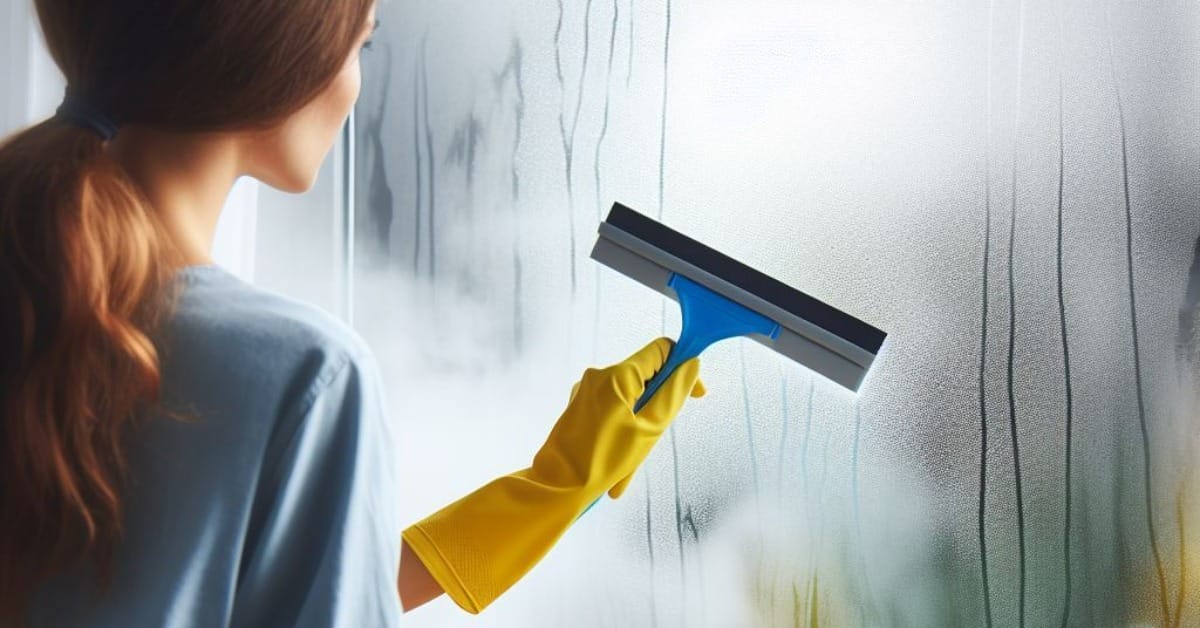
Let’s dive into an often-overlooked aspect of our homes – windows. They provide essential natural light, refreshing air, and a connection to the world outside. But, they can also bring a little challenge, like condensation.
Here’s a rundown of top tips to tackle condensation and keep your windows clear and your home comfy:
🏠 Seal and Insulate: Upgrade your windows to keep moisture out.
💧 Spot the Wet Culprits: Identify and reduce indoor humidity sources.
🌬️ Vent it Out: Use exhaust fans to whisk away moisture.
🔍 Ventilation Check: Ensure your home breathes right.
🛠️ Expert Eye: Call the pros for a deep-dive diagnosis when in doubt.
Let’s dive in deeper below!
Causes of Window Condensation
Window condensation occurs when moisture in the air comes into contact with a cold surface, such as a window pane, and turns into liquid. Several factors contribute to this:
- Indoor Humidity: High moisture levels inside your home are the primary cause of window condensation. This moisture can come from daily cooking, bathing, laundry, and breathing.
- Poor Ventilation: Inadequate ventilation can trap moist air inside your home. Modern homes are often well-sealed for energy efficiency, which can inadvertently lead to reduced air circulation.
- Temperature Difference: A significant temperature difference between the inside and outside of your home can cause condensation. During colder months, the warm air inside meets the cold surface of the window glass, leading to condensation.
- Inefficient Windows: Older or poorly insulated windows are more prone to condensation because they allow more heat transfer, making their surfaces colder than the room temperature.
- Houseplants: While they are great for air quality, houseplants can significantly increase indoor humidity levels as they release moisture into the air.
- Appliances and Equipment: Certain home appliances, like humidifiers, can raise the moisture levels in your home. Even unvented gas or kerosene heaters can release a lot of moisture into the air.
Understanding these causes is key to addressing the issue effectively by adjusting your indoor habits, improving home ventilation, or upgrading your windows for better insulation.
Strategies to Prevent and Manage Window Condensation
Window condensation can be a real dampener, not just on your windows but also on your home’s overall comfort and health.
We’ll explore effective strategies to prevent and manage window condensation, ensuring your home stays well-insulated, moisture-free, and comfortable.
1. Weatherize Your Windows
When it comes to preventing condensation on windows, weatherizing them is a crucial step that shouldn’t be overlooked. Proper insulation is key to keeping moisture at bay and maintaining a comfortable indoor environment.
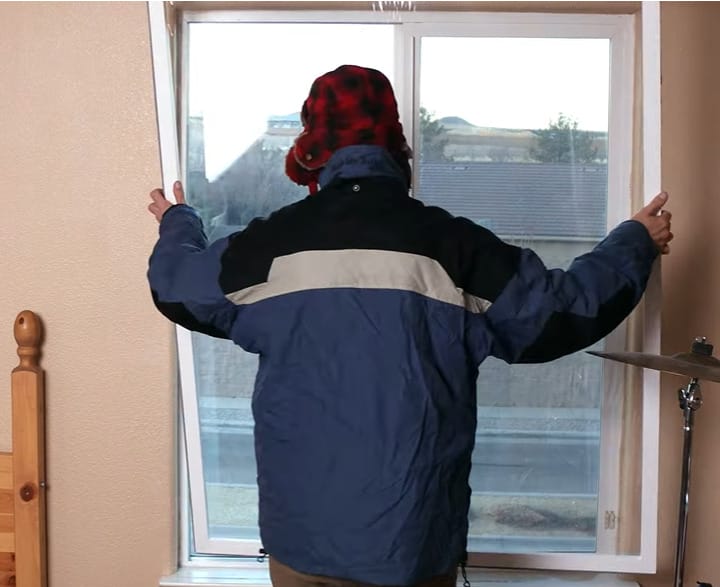
One effective way to weatherize your windows is by adding storm windows. These windows are installed on the exterior of your existing windows, creating an extra layer of insulation that helps keep the cold and warm air out. This can significantly reduce the amount of condensation that forms on your windows.

Another important factor to consider is the quality of your window seals. Poorly sealed windows let cold air seep in, creating a prime condensation environment. Check your window seals regularly and replace them as needed to ensure that your windows are properly sealed.
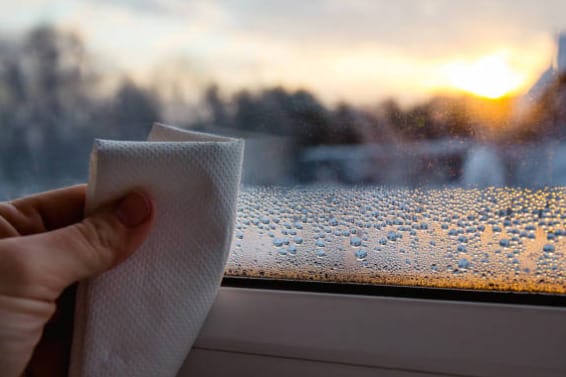
Finally, it’s important to control the humidity levels in your home. High humidity levels can lead to excess moisture in the air, contributing to window condensation. Use a dehumidifier to keep indoor humidity levels in check, and ensure your home is well-ventilated to allow excess moisture to escape.
2. Start Eliminating Easy-to-Spot Sources of Humidity
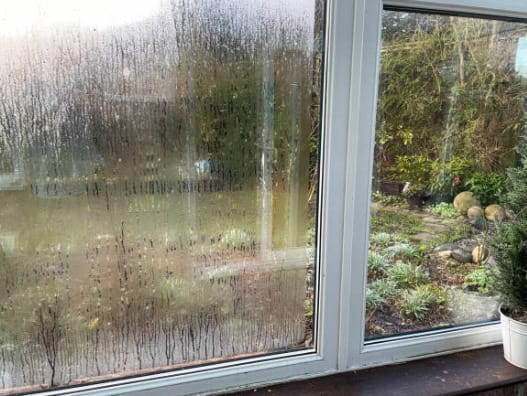
As I work on fixing condensation on windows, the first step is to start eliminating easy-to-spot sources of humidity. These sources of humidity include:
- Plants: Plants release moisture into the air as they grow, so move them off your windowsill during the cold season.
- Cooking: When cooking, use the exhaust fan to remove excess moisture from the air.
- Showering: Use the bathroom exhaust fan when showering to remove excess moisture from the air.
- Drying Clothes: Hang wet clothes outside to dry or use a dryer that vents to the outside.
- Aquariums: Cover aquariums to reduce the moisture that escapes into the air.
- Leaks: Fix any leaks in your plumbing or roof to prevent excess moisture from entering your home.
By eliminating these sources of humidity, you can reduce the amount of moisture in the air and prevent condensation from forming on your windows.
3. Enlist Exhaust Fans to Ventilate Excess Moisture
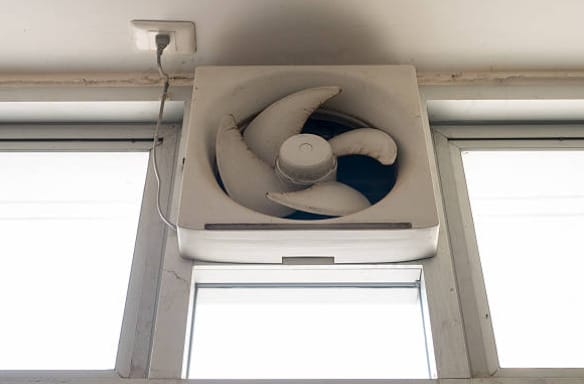
One effective solution to preventing condensation on windows is to use exhaust fans to ventilate excess moisture. This is especially important in areas of high humidity, such as the bathroom and kitchen.
Exhaust fans work by removing the moist air from the room and replacing it with fresh, dry air from outside. This helps to reduce the amount of moisture in the air, reducing the likelihood of condensation forming on windows.
In some cases, it may be necessary to install additional exhaust fans to ventilate the space adequately. This is particularly true in larger bathrooms, kitchens, or areas where a lot of moisture is produced, such as in a laundry room.
4. Check for Other Ventilation Issues

When dealing with condensation on windows, it’s important to check for other ventilation issues in your home. Poor ventilation can lead to excess moisture buildup, which can cause condensation on windows and even more serious problems like mold and mildew.
To start, check your home’s ventilation system. Ensure all vents and fans are working properly and are not blocked or obstructed. You may also want to consider investing in a dehumidifier to help reduce moisture levels in your home.
In addition to checking your ventilation system, it’s also important to look for other sources of moisture in your home. Leaks in your plumbing or roof can lead to excess moisture buildup, so check for any signs of water damage or leaks.
Finally, be sure to properly ventilate areas of your home that produce a lot of moisture, such as the kitchen and bathroom. Use exhaust fans or open windows to help circulate air and reduce moisture levels.
5. Hire a Pro to Find the Source of Condensation
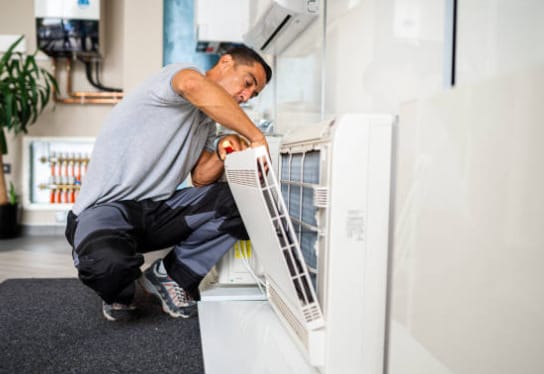
When you have tried all the DIY methods to fix condensation on your windows, and nothing seems to work, it might be time to call in a pro. A professional window contractor can help you identify the root cause of the problem and recommend the best course of action.
A qualified contractor will have the necessary tools and expertise to diagnose the issue and determine whether it is caused by poor ventilation, improper insulation, or other factors. They can also help you choose the right type of windows and install them correctly to prevent future condensation problems.
Before hiring a contractor, research and choose a reputable company with a proven track record of success. Look for online reviews and ask for past clients’ references to ensure you get quality service.
Remember, hiring a pro may cost more upfront, but it can save you money in the long run by preventing further damage to your home and ensuring that your windows function properly. So, don’t hesitate to contact a professional if you need help fixing condensation on your windows.
DIY Fixes vs. Professional Solutions
Two main options for fixing condensation on windows are DIY fixes and professional solutions.
Depending on the severity of the problem, one may be more appropriate than the other. Here’s a breakdown of the pros and cons of each option:
| Aspect | DIY Fixes | Professional Solutions |
|---|---|---|
| Cost | $10 – $50 (materials only) | $100 – $500+ (labor + materials) |
| Ease of Implementation | Easy to do | Requires professional expertise |
| Effectiveness | It may not solve severe problems | Guaranteed to solve the problem |
| Time for Completion | Can be done quickly | It may take longer to schedule and complete |
Ultimately, the choice between DIY fixes and professional solutions will depend on the severity of the problem and your budget. If you’re unsure which option is right, consult a professional for their expert opinion.
Maintaining Clear Views: Long-Term Condensation Prevention
As someone who loves a clear and unobstructed view from their windows, I know how frustrating it can be to deal with condensation. While there are quick fixes like wiping down the windows or turning up the heat, it’s important to think about long-term solutions to prevent condensation from forming in the first place. Here are some tips that can help:
- Improve ventilation: Proper ventilation is key to preventing condensation. Ensure that your home has adequate ventilation through vents or windows that can be opened. You can also install a ventilation fan in high-moisture areas like the bathroom or kitchen to help remove excess moisture from the air.
- Reduce humidity: High humidity levels can contribute to condensation on windows. Use a dehumidifier to remove excess moisture from the air and keep humidity levels comfortable. You can also take steps like covering pots when cooking and drying clothes outside to help reduce humidity levels.
- Upgrade your windows: They may contribute to condensation if old or poorly insulated. Consider upgrading to double-paned windows or adding weatherstripping to improve insulation and reduce the likelihood of condensation forming.
- Use window treatments: Window treatments like blinds or curtains can help reduce the amount of moisture that comes into contact with your windows. Keep them open during the day to allow for proper ventilation and sunlight.
- Keep your home warm: Keeping your home warm can help reduce the likelihood of condensation on windows. Ensure your heating system is in good working order, and consider adding insulation to your home to keep it warm and dry.
By implementing these long-term solutions, you can help prevent condensation from forming on your windows and enjoy clear views all year round.
Knowing When to Call in the Experts: Signs of Larger Issues

Knowing when to call the experts for help with window condensation is important for a homeowner. While some condensation is normal, excessive condensation can signify larger issues requiring professional attention. Here are some signs to look out for:
- Water Damage: If you notice water damage around your windows, such as peeling paint or warped wood, it’s a sign that there may be a leak. Leaks can lead to mold and mildew growth, harming your health.
- Foggy Windows: If you notice foggy windows that don’t clear up, it may be a sign of a broken seal. Broken seals can lead to energy loss and decreased efficiency in your home.
- Ice Buildup: If you notice it on your windows, it’s a sign that your home is not properly insulated. Poor insulation can lead to energy loss and increased utility bills.
Calling a professional to assess the situation is important if you notice any of these signs. A professional can help identify the root cause of the problem and provide solutions to fix it. Don’t wait until the problem gets worse – call in the experts today.
Frequently Asked Questions
- Are Certain Rooms More Prone To Condensation?
- Yes, especially areas with more moisture, like kitchens and bathrooms. Ventilation is crucial here. Ensure those exhaust fans work, and consider cracking a window while cooking or showering.
- Is Condensation A Bigger Issue In Older Homes?
- Often, yes. Older homes may have less efficient windows and insulation, making them more prone to condensation. It’s worth considering some upgrades if you live in an older property.
- Can Cooking And Showering Affect My Windows?
- You bet. Both activities pump a lot of moisture into the air. Always use exhaust fans, and keep lids on pots when cooking to minimize the moisture release.
- How Do I Balance Home Heating With Condensation Control?
- It’s like a dance – you want your home cozy but not overly warm and stuffy. Use your heating wisely and consider a programmable thermostat for better temperature control.
References
Organizations:
- Energy Star. https://www.energystar.gov/
- American Society of Heating, Refrigerating and Air-Conditioning Engineers (ASHRAE). https://www.ashrae.org/
Books:
- “The Homeowner’s Handbook to Energy Efficiency” by John Krigger and Chris Dorsi. https://www.buildersbook.com/the-homeowner-s-handbook-to-energy-efficiency-a-guide-to-big-and-small-improvements.html
Website Resources:
- This Old House. https://www.thisoldhouse.com/
- U.S. Department of Energy. https://www.energy.gov/energysaver/weatherize
Video References:
Build It Make It
